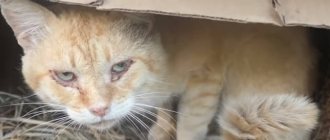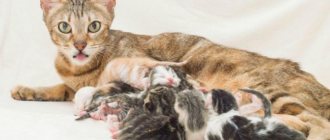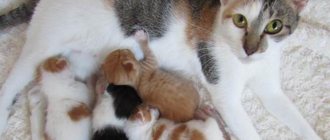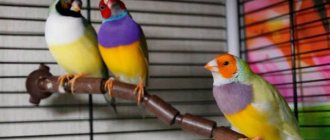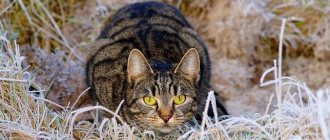10692Pavel
1
When deciding for the first time to start breeding Scottish Fold cats for commercial purposes or for themselves, the owner must know exactly everything about the birth of kittens. In most cases, the birth of a Scottish cat takes place without complications, and the four-legged mother only needs the support of the owner for a more comfortable birth of the kittens.
During pregnancy, a cat requires high-quality nutrition and careful monitoring of its condition. If the mating was the first and the Scottish female is still too young, she can give birth to only one kitten.
More mature cats that give birth more than once give birth to 5 to 7 kittens. The duration of labor in a normal course can last up to a day. Pregnancy lasts from 56 to 71 days, most often the birth of kittens occurs on the 65th day.
© shutterstock
What to do with newborn kittens
After the first kitten is born, cut the umbilical cord 2 cm from the tummy. Then tie it with thread and disinfect it. After this, you need to place the baby near the mother's nipples. This way she can lick him and feed him. The final stage for you: it is recommended to wipe the baby with a dry cloth after the first feeding. After this, place him on a warm heating pad. Do the same with the rest of the kittens.
When the due date comes, take care of the newborn babies and the mother in labor. Sometimes this process turns out to be difficult and lengthy, especially if the Scottish woman gives birth for the first time. Be patient and you can get beautiful Scottish kittens.
When to start counting the pregnancy period
To understand how long the pregnancy duration of a Scots cat is for a given period, you need to know the exact date of mating of the cat. It is from this date that the first day should be counted. Naturally, if the mating took more than one day, then it is necessary to allow an error in the calculations of 1-2 days.
If for some reason you do not know when the mating was made, then you just have to wait for the first signs of pregnancy.
Symptoms and signs:
- The pet is gradually becoming rounder and gaining weight. Morning sickness and vomiting are possible. There are manifestations in the form of an apathetic state, lethargy and slight malaise. Changes in diet. The pet may begin to eat either more or less.
All these signs can appear by 3-4 weeks and are short-term in nature. This condition is caused by physiological changes, namely: changes in hormonal levels, growth and development of the uterus.
What is considered a deviation from the norm
As mentioned earlier, there are standards that show that the duration of pregnancy in Scottish cats is 65 days . However, there are also indicators that should cause concern.
A deviation from the norm is considered:
- If kittens are born earlier than 60 days from the start of pregnancy. In this case, the litter will simply die, as it will not be capable of life.
- If the kittens do not appear after 67 days, then this is also not a normal course of pregnancy. From the 68th day, the litter will be considered post-term. In this case, you should urgently take the cat to the veterinarian.
Superfetation
Superfetation is an interesting phenomenon that manifests itself in the form of a second pregnancy during an existing pregnancy. That is, if a Scottish cat’s pregnancy has been going on for some time, but suddenly she begins to “walk” and then the cat is re-fertilized, then there is a possibility of a “double” litter.
Of course, superfetation is more of a hormonal problem. When a problem occurs in a cat’s head and her body does not produce the proper level of progesterone.
The first and main sign of possible superfetation is estrus in a pregnant Scottish cat. It is at this moment that if a cat is allowed near her, then re-fertilization can occur.
Estrus can begin when the duration of pregnancy of a Scottish fold or straight-eared cat has reached 20-40 days.
If superfetation occurs, then several scenarios are possible:
- The first and second litters will be miscarried at the same time.
- The first healthy litter will be born and the second will be premature and dead.
- The first litter will be born and after a while the second litter.
© shutterstock
Even if events develop according to the third option, there is a possibility that the cat will not have enough milk to feed two litters in a row. Therefore, it is best to avoid superfetation.
Breeding Scottish Fold cats
The Scottish Fold cat becomes an adult at the age of about 8 months. During this period, she begins to tell her owners about her personal life and loudly demand freedom. Breeders do not recommend breeding a cat when she is in her first heat. Such a cat has not yet matured physically, and early pregnancy will negatively affect its health. The first date with the cat should be arranged only after the start of the third heat and not earlier than the animal turns one year old.
In order for a cat’s pregnancy to go smoothly, it is necessary to prepare for its onset. The cat must be healthy, strong and able to bear and feed kittens.
Mating of Scottish Folds is possible only with straight-eared representatives of the breed. This rule cannot be broken: kittens born from two fold-eared animals most often do not survive. The reason for this is the lop ear gene, which is also responsible for the musculoskeletal system. In order for babies to be born alive and healthy, a straight-eared Scottish Straight cat must become a partner for a fold-eared cat.
You need to prepare carefully for breeding fold-eared cats. When choosing a partner, it is necessary to take into account the state of his health, the presence of vaccinations and the absence of parasites, as evidenced by the animal’s documents.
Childbirth process
If a Scottish cat has given birth for the first time, we cannot rule out the possibility that she will get scared of what is happening and do something wrong. For this reason, you need to constantly be near your pet, calming it down and providing assistance if necessary.
The entire birth process can be divided into several stages:
- removal of the plug;
- contractions - during this period the uterus opens and the kittens line up in a certain order convenient for birth;
- pushing;
- the birth of the first kitten and subsequent ones;
- passing of the placenta.
It is important to remember that pushing continues all the time until all kittens are born.
Pregnant cat diet
The menu for a pregnant Scottish cat must be carefully prepared. She must receive not only enough calories, but also nutrients. Therefore, it would be useful to purchase a complex of vitamins and minerals for pregnant cats at a veterinary pharmacy.
In the first two weeks of pregnancy, the animal eats as usual. An exception may be a young or weak expectant mother. Such murkas should slightly increase the portion.
Over time, the cat begins to feel an increasing appetite.
Kittens take up a lot of space in the abdominal cavity, and the cat cannot eat too much. Therefore, it is better to increase not the serving size, but the number of meals.
In the middle of the term, a pregnant Scottish cat eats four to five times a day. But by the end of the term, she can eat three times more than usual. You shouldn’t limit mommy’s treats.
If your cat eats special food, it is recommended to gradually introduce kitten food into its diet. By the end of pregnancy, the entire menu should consist of canned food for babies.
Kitten food
With a natural diet, half of it should consist of boiled meat products. A pregnant Scottish Fold cat should also be treated to:
- boiled low-fat fish;
- boiled eggs;
- porridge;
- vegetables.
For digestion, it is useful to add vegetable oils to the diet, as well as beet puree. To make childbirth easier, you can give your Scottish cat an infusion of raspberry leaves. One spoon in the morning and one in the evening throughout pregnancy. To improve the formation of milk, it is recommended to introduce a salad of scalded nettle leaves into the murk’s diet.
Owner's actions during childbirth
If cats are bred by a cattery, then giving birth to a cat is nothing new for the owners, and they can accurately and quickly do everything necessary. Those who are giving birth to a Scottish cat for the first time need to prepare everything they need in advance and remember exactly the order of their actions.
It is important to calm the pet down and lay it on its side, as this position is the safest for newborn kittens and most comfortable for the cat. If the Scottish female tries to sit up, which sometimes happens in first-time mothers, this should be prevented, since otherwise both the kittens and the mother will be injured
Childbirth in a Scottish Fold cat usually takes place without extreme situations, which does not happen with all breeds.
As soon as the pet begins to give birth and contractions appear (they can be determined by the wave-like movements of the abdomen), she should be injected subcutaneously with 1 ml of Traumatine and Gamovit. You should not combine medications in 1 syringe. This is required to facilitate childbirth and quickly recover after it.
The first kitten born immediately begins to suckle from its mother, which stimulates labor and facilitates the birth of other kittens.
shutterstock
First signs of labor
The first signs of labor in a Scots cat can be seen just before the kittens appear. It would not be amiss to note that in a British cat everything happens in a similar way. In the period before birth, about 30 hours before it, the cat's rectal temperature changes and is only 37 degrees instead of 38.6 (as usual), but it recovers within a few hours. This sign of approaching labor can sometimes be missed due to its transience.
On the day of birth, your pet’s behavior changes, she begins to actively lick the genital area, as well as the abdomen, becomes restless, actively purrs and rummages in the prepared box or place that she herself has chosen as a birthing area. The beginning of labor for tartans is considered to be the moment the plug comes out, which can be determined by the release of bloody clots or a brown jelly-like mass.
© shutterstock
Stages of pregnancy
At the first stage, signs of pregnancy are not noticeable.
At the first stage, which lasts about two weeks, it is almost impossible to notice changes in the cat’s appearance.
Starting from the third week, a pregnant cat changes noticeably. Changes in hormonal levels provoke mood swings. The expectant mother can be very affectionate, or, conversely, show aggression. Also during this period, you should not carry the cat in your arms and allow it to jump from a height. If the cat needs to be moved, then one of your hands should be under its chest, and the other should hold its butt.
The fourth week of pregnancy is accompanied by a growth in the tummy and appetite. Murka eats more and more often, and she shouldn’t be denied treats.
In the fifth week, the cat noticeably becomes rounder. During this period, kittens begin to actively gain weight. The cat senses them and begins to look for a secluded place to make a “nest”.
Don't worry if this happens in the middle of the term. The expectant mother needs to get used to the house; she will spend a lot of time there.
From 40 to 50 days, kittens begin to acquire fur. Often the cat's appetite worsens and she becomes even more sleepy, spending even more time in the nest.
In the last weeks of the pregnancy, the pregnant cat begins to worry. She demands increased attention from her owner, and also restlessly searches the house in search of an even more comfortable place. If Murka often went for walks, now she spends more and more time at home.
By placing your hand on the stomach, you can feel the kittens moving. You can find out the number of babies using an ultrasound examination.
Duration of pregnancy in cats
It is impossible to designate an exact, uniform number of days for everyone. For each individual, this period proceeds in its own way, perhaps, like in humans, prematurity and postmaturity.
The number of days gestation for all felines is strongly influenced by a number of circumstances:
- how many embryos were formed in the female;
- how old (or even months) is the expectant mother;
- individual health characteristics.
The duration of an interesting situation in cats is on average nine weeks, and the possible number of days ranges from 58-72.
Preparing for childbirth
What needs to be prepared for the birth of a cat
The owner must remember the estimated date of future birth. It is also necessary to understand that they may occur ahead of schedule, so the first aid kit should be prepared in advance:
- scissors with blunt ends for cutting the umbilical cord;
- disinfectants;
- diapers to dry babies if necessary;
- a small enema to clear the kittens' airways of fluid;
- clean bedding to move the cat family onto after giving birth;
- Doctor's phone number. It is worth pre-arranging with the veterinarian the date when he may need to come to your home.
As mentioned above, the cat needs to be provided with a corner where she can give birth to kittens. This could be a clean box or basket. You need to place it in a quiet place without drafts. The bedding should be warm and pleasant to the touch. For the birth itself, it is worth using unnecessary material, since after the process is completed it will no longer be suitable.
Prepare the place for childbirth
If a cat carries kittens for more than 68 days, you need to contact a veterinarian to check the health of the expectant mother.
Birth
The beginning of this stage marks the appearance of the fetus. It is a bubble with light yellow liquid. A special fluid lubricates the birth canal to facilitate the process.
In a few minutes the next baby should appear. Typically, cubs are born head first, and then the body emerges from the mother's body.
The mother tears open the bubble surrounding the baby and licks it to clear the airways of fluid. The kitten takes its first breath and its lungs expand. The cub is now breathing on its own.
As a rule, the woman giving birth does everything necessary on her own. If she is not in a hurry, she should break the bubble so that the baby does not suffocate. You need to tear the shell from head to tail, then you should immediately pump out the liquid from the baby’s nose using a syringe or pipette.
When a newborn makes a squeak, you can be sure that he is breathing. Now it’s time to dry the kitten with a soft towel and return it to its mother.
Preparing the birth site
For the normal birth of kittens, a fold-eared cat, like any other, requires comfortable conditions. The birthing box should be prepared in advance so that the pet has time to get used to it
It is very important that the environment in which the cat will give birth is homely and familiar to her. The birth box needs at least the following dimensions:
- length – 60 cm;
- width – 50 cm;
- height – 50 cm.
If the cat is very large, a larger box may be required. It is best to make one of its walls removable. This will allow, after the kittens are born, to carry out all the necessary actions to keep the bedding clean with the least amount of worry, and will also prevent the cat from jumping into the box from above, during which she could accidentally injure, or even kill, the kitten. The ideal bedding would be a thick layer of newspaper.
The kitten birth box should be placed in a warm, dry room in a dark place. The birth should take place without people or animals being strangers to the cat, which can become an additional source of stress for the Scottish cat, which will make the birth process more difficult.
Factors contributing to successful mating
Domestic cats become sexually mature at 6–8 months, depending on the breed and individual characteristics. Neither males nor females are ready for full mating in the first “hunt”. Stray animals mate at this age, which leads to death or infertility in an average of 30% of females, a reduction in sexual productivity in 50% of males - a natural way of controlling the birth rate and population of wild animals.
It is believed that the female is ready to bear kittens at the age of 1.3–1.5 years. For successful “cooperation” with a cat, the owners of the female need to take into account several points:
The search for a “spouse” may take a long time; you need to start 4–6 months before the planned mating. Remember that animals may not like each other, so have a backup plan.
Three months before mating, cats must be examined for infectious diseases, and tested for viruses a month before.
The cat is not vaccinated for 14–20 days.
Preventive deworming is carried out 14 days in advance.
Future partners do not bathe and trim their nails immediately before mating.
The meeting takes place on the territory of the cat; appropriate conditions must be prepared for the female.
How to breed Scottish cats
Mating of a Scottish Fold or Straight should take place around the third day of estrus. The knitting process itself takes 2-3 days.
In order for the mating to be successful, it is advisable to prepare a place, a fenced-in space, from where the Scottish Fold cannot escape. This is important if the pets will mate for the first time.
Animals become interested in each other within a couple of days, during which time approximately 10-15 close contacts with the cat can occur.
Ovulation in a female occurs directly during intercourse and its quality, and therefore the likelihood of becoming pregnant, directly depends on the experience and behavior of the cat with whom she was mated.
The reason is that the lop ear gene not only causes the ears to droop, but also weakens the cartilage in the body and tail of the animal. Such mating can produce very weak babies.
Therefore, folds must be mated with straight-eared cats in order to dilute the fold-eared gene. Only in this case is guaranteed healthy offspring without pathologies of the musculoskeletal frame.
Mating is not always successful. There are a number of reasons why the desired pregnancy never occurs. Usually, the owners of the female simply need to conclude an agreement, make a payment and bring the cat for mating, while the owners of the cat must know all the features of mating and proper fertilization of the Scots.
The most common problem is when the female does not allow the cat to approach. In this case, the cat's owners can stimulate the female's arousal process by stroking her in the genital area, as well as on the back and sides. Sometimes special medications are required to induce ovulation. The third option is to replace the male with a more experienced, persistent, but delicate one.
The opposite situation happens - the cat does not approach the cat. He might just not like her. The cause may also be the groom’s childhood psychological trauma. If he was offended by a cat of a similar color as a kitten, then he may avoid them on a subconscious level. All that remains is to change the partner.
The Scottish woman falls on her side during intercourse and, accordingly, takes the wrong pose for crossing. Sexual intercourse in this case is practically impossible, especially if the male is not experienced. To help fertilization, the owner can hold the girl during the act, providing a comfortable position for conceiving offspring.
According to all the rules, before mating, an agreement is concluded with the owner of the male, which indicates the timing of mating, the price and the guarantee of pregnancy. If it does not occur, then the owner should be ready to conduct an additional 1-2 matings for free.
We suggest you read: Pancreatitis in cats: symptoms and treatment
You should know some rules that make mating safe from a physical and psychological point of view.
- Usually the date takes place on the cat’s territory, so its owner needs to set up a mating area; it is better to allocate a separate room.
- If partners show aggression, it is worth postponing mating actions; they need time to courtship and get used to each other.
- The cat owner must control the situation and, if necessary, help the animals get closer. In particular, he must control the cat's posture.
Possible complications of pregnancy, how to identify them in the early stages
Great risks are associated with mating after any kind of surgery. If a cat has survived anesthesia, its health has received a serious “blow” and you can start talking about mating only after the veterinarian’s permission and a comprehensive examination. In any case, mating is not planned until complete rehabilitation, sutures have been secured and scar tissue has formed.
Some cat breeds are notoriously problematic in terms of bearing offspring and childbirth. Pedigree breeders know about the pitfalls, but if you are not an experienced owner and have a purebred cat, be sure to consult the club about possible complications.
Bearing and giving birth to kittens in a British cat is associated with certain risks. The significant superiority in size of the male over the female, the majority of large kittens and the narrow pelvis of the cat can negatively affect the birth process. Problems are more common in Scottish cats due to genetic mutations. This does not mean that the animal is not able to give birth, but only that it needs to be given more attention and examined in detail. The Sphynx is a more problematic pet in terms of childbirth and new obstetricians are not recommended to deliver babies on their own. However, thanks to the control of widespread crossbreeding and the comparative “freshness” of the blood, only 10–15% of cats “fall” under caesarean section, which cannot be said about Persian, “new” Siamese, oriental cats.
Newborns
During the first 21 days of life, normal cubs only feed on milk and doze. In most cases, the mother independently looks after the babies and their bed. After the first week, kittens begin to develop eyes. They begin to fully see the world around them by two weeks. All newborns have heavenly colored eyes.
It is replaced with a permanent one in the third month. Babies' ears open on the 5th-8th day after birth, and straighten after 2 weeks.
The fluffies try to get up from the age of 18 days, and after another four days they can walk. From now on, they can eat from a plate themselves. If possible, you should not disturb the kittens again before they learn to crawl, since the mother will worry if someone touches her babies.
It is believed that the Scottish baby, caressed by people, will not get along well with his mother and the entire litter in the future. But if there is no communication with a person at all, the animal may show fear and anger, and become a slob.
Knitting - nuances of the process
Living together with cats can last up to 3-5 days. If the cat and cat are experienced or well-matched, the process can be completed in a few hours. The optimal mating period occurs 3–5 days after the cat starts estrus. After the move, civil strife and even fights may arise, so the female should have the opportunity to retire and relax.
During “flirting”, the cat herself provokes the cat into activity, after which she demonstrates “aggression”, and the male retreats. The procedure can be repeated up to 10 times, depending on the temperament of the animals. Covering may also occur several times without being successful. Owners need to know what signs indicate a successful mating:
After digging, the cat rolls around on the floor.
The mucous membranes of the genital tract swell and become brighter in color.
The cat loses active interest, may move to the side, and actively licks itself.
When repeated advances are made, the cat receives a sharp refusal.
After mating, the cat is taken home and allowed to recuperate. The animal may lose its appetite and behave apathetically for 3-4 days; this is normal. Owners should be wary and show their pet to a doctor if the cat has a fever or bleeding from the genital tract.
Nutrition
The food that you will consume should be as healthy and of high quality as possible. Contain proteins, vitamins, proteins and microelements. Her diet during this period can be divided into 3 stages:
- From 1 to 3 weeks. These days, her appetite becomes significantly higher; accordingly, the amount of food should increase by 10-20% of the norm. The cat needs to be fed approximately 4-5 times a day;
- From 3 to 7 weeks. The amount of food consumed increases by 2 times due to an increase in the number of feedings. The portion should remain the same, since the small stomach of a Scottish woman may not digest a large amount of food.;
- Presumably, appetite decreases from 2 months. This is explained by the fact that babies, together with the uterus and amniotic fluid, significantly compress the gastrointestinal tract. Therefore, the amount of food needs to be reduced, but fed as before, 4 to 5 times.
Signs of pregnancy in cats - from mating to the first weeks
The desire of the owners and the murka to acquire squeaking offspring is only the beginning of the journey. Moreover, when the “union” happens not out of love, but according to the laws of genealogy. In free-roaming cats, the process of choosing a partner is a whole ritual in which the strongest male wins. Pedigree cats do not have the same privileges; no matter what cat is given, they have to start a family, and such restrictions often lead to “false” matings. The first signs of pregnancy in cats are a vague concept and in many cats they are simply absent. Nevertheless, let us highlight the main points of “diagnosing” pregnancy.
